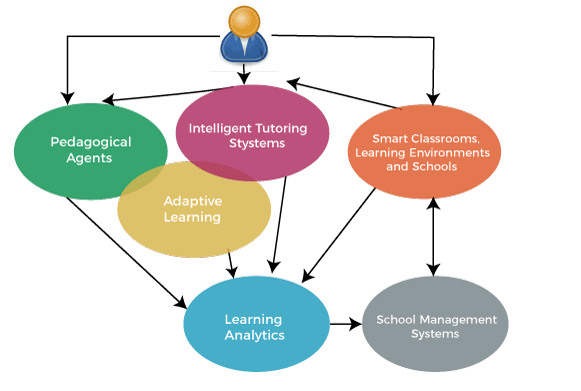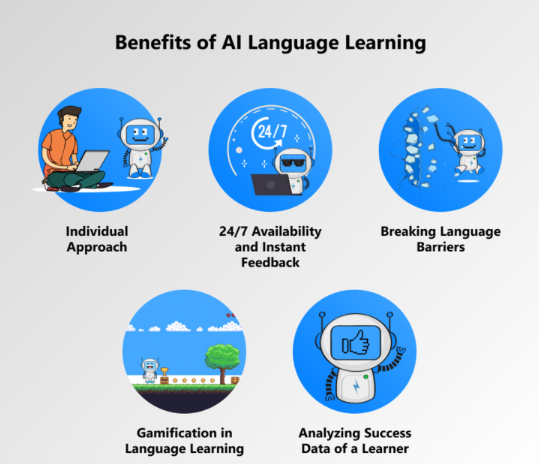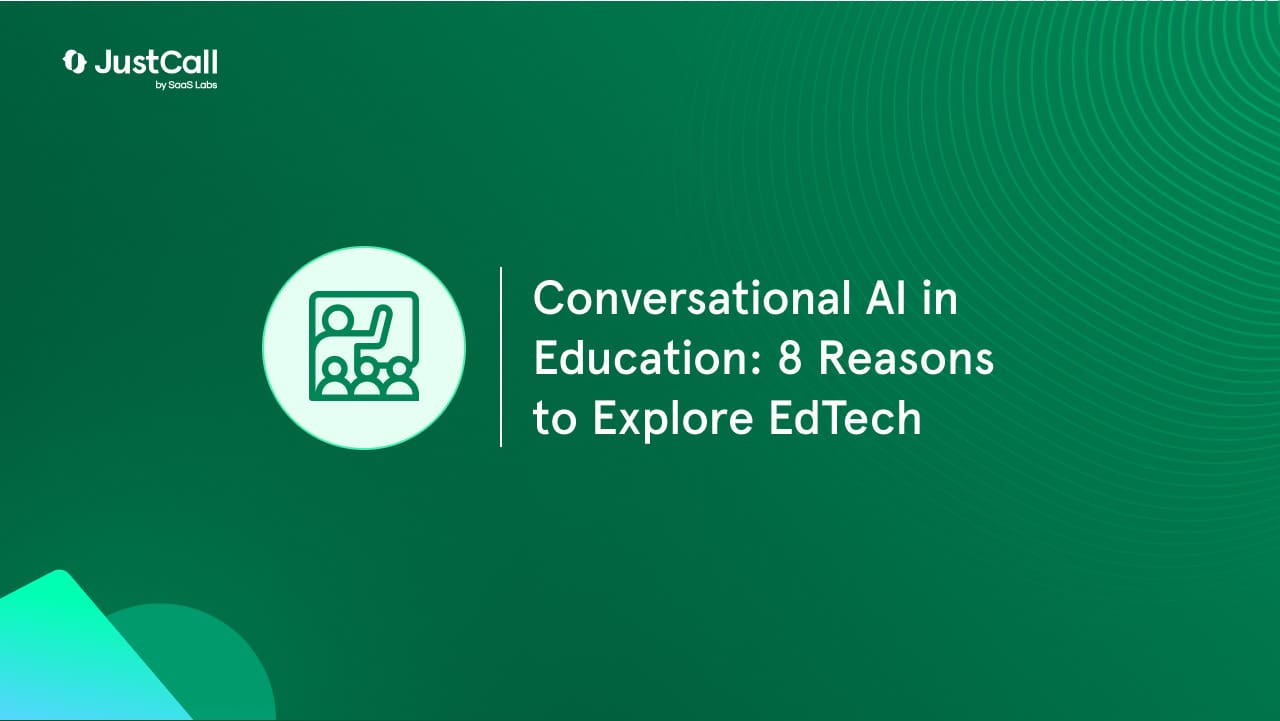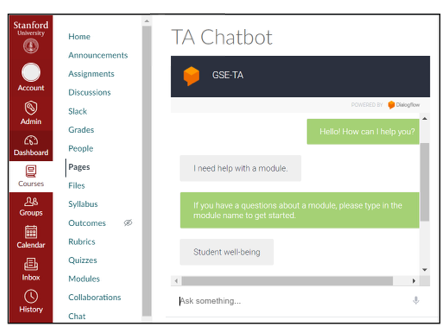Imagine having a virtual companion that engages students, supports learning, and fosters curiosity. An aid that is available 24/7.
That’s what conversational AI brings to the educational sector. It gives a new dimension to education with personalized assistance, instant feedback, and a seamless learning experience.
By using natural language processing and machine learning, conversational AI unlocks new potential in education. As it continues to develop, students and teachers can look forward to even more benefits of AI in education.
Uses of Conversational AI in Education
There are many specific ways that conversational AI can boost the process of education. To begin with, it can be used to create personalized learning experiences for students.
Virtual tutoring can be done through chatbots or other interfaces. This can be very helpful when it comes to answering student questions, providing feedback, and helping to understand difficult concepts.
With automated grading and analysis, conversational AI can free up time for teachers and administrators. They can focus on other tasks, such as mentoring and supporting students.
In all these ways and more, the use of AI in the education sector boosts adaptive learning and delivers tailored content. The process of education becomes engaging and fulfilling.

Benefits of Conversational AI in Education
Let us now sum up and underline the benefits of conversational AI in the education industry.
- It provides personalized and interactive learning experiences.
- Through virtual assistants, it provides fast responses, explanations, and guidance.
- It can help students with disabilities through voice-activated interfaces.
- It can provide multilingual support for non-native speakers and language learners.
- Conversational AI streamlines administrative and routine tasks to make the lives of teachers simpler.
- It is available round-the-clock for support and guidance.
- It is capable of monitoring progress and identifying areas for improvement.
- The use of conversational AI in education can accommodate diverse learning needs and styles.
- Conversational AI systems can improve communication between students, teachers, and parents. This leads to a more collaborative learning environment.
Achieve Contact Center Excellence With JustCall AI
Eight Great Use Cases
Here are eight specific ways in which the use of conversational AI can transform education across the board:
1. Smart Content Creation
Conversational AI can help to make classroom content engaging and fun. For example, it can generate interactive content such as simulations, games, and quizzes.
It can also create lesson plans for teachers. Complex material can be broken into chunks for easy assimilation.
Audio and video guides can be generated for better understanding. Students can absorb the information at their own pace. Feedback on the learning modules can be instantly available to track progress and make any necessary adjustments.
2. Digital Classrooms
Conversational AI can effortlessly enhance virtual learning environments. These can be personalized and interactive.
Virtual assistants can help students and teachers with immediate support. They can answer questions, and otherwise guide them through the learning process.
Conversational AI assistants can spark discussions and offer personalized feedback. Another important use case is that they can facilitate collaboration among students. This lets them work together on projects and share resources even though they may not be physically in the same room.
In this way, conversational AI in digital classrooms enhances engagement, increases accessibility, and enables rich learning experiences.
3. Data-based Analysis
Conversational AI can be used to collect and analyze data about student performance and learning styles. This technique enables data-driven decisions to improve teaching methods.
The data can identify students who need extra support. Educators can also make informed decisions about curriculum and instruction.
Data can be collected through various means such as surveys and quizzes. The analysis can also be used to track student progress and identify trends in learning. Teachers can get feedback on methods of instruction and suggestions for improvement.
4. Exam Monitoring
Conversational AI can make exam monitoring more efficient and effective. It can check student behavior during virtual exams, such as how often students are looking away from their screens, or how often they are using their phones.
Conversational AI can also be used to provide real-time feedback to students during exams. They can receive suggestions about staying on track, answering questions on time, and advice on administrative issues.
This feedback could be used to help students stay on track or to identify areas where they need additional help. It can also be a way for students to ask questions or report concerns, or for teachers to provide digital feedback to students.
5. Language Learning
Conversational AI can shine when it comes to language learning. AI-powered language learning platforms can offer interactive dialogue and real-time feedback. These methods let students practice speaking and comprehension skills in a realistic and engaging manner.
Conversational AI can simulate conversations, provide vocabulary guides, and offer pronunciation tips. Conversational AI chatbots can tailor instruction to individual students, depending on their levels of proficiency and learning styles.
Language learners can access a virtual language aid that can assist them anytime, and anywhere.

6. Syllabus and Content Updating
Conversational AI can play a significant role in ensuring that content and syllabi are always up to date. AI-based tools can identify outdated content by analyzing learning material. For example, natural language processing can identify keywords that are no longer relevant.
After that, conversational AI can suggest new content based on student performance data. The suggestions can improve areas that students are finding hard to understand.
The process of updating materials can be done automatically. This frees up the time of educators and administrators.
7. Long-term Trend Spotting
Apart from day-to-day use cases, conversational AI can also be a valuable source of data to spot trends in educational practices. Educators can track how well students are performing in certain disciplines, which areas are popular and unpopular, and which methods of instruction work the best.
With this analysis, administrators can make informed decisions about the future of schools, colleges, and academies. They can drop old courses, make changes to existing ones, and add infrastructure and resources to prepare for the future.
8. Upskilling and Life-long Learning
Conversational AI can also be profitably used for purposes of continuing education beyond the academy. It can come up with customized learning plans based on individual goals, interests, and learning styles.
Conversational AI checks existing skills and knowledge through interactive assessments. It identifies skill gaps and focus areas. Learners can access on-demand learning support and resources.
AI-based tools and techniques can provide industry-specific knowledge, best practices, and case studies. These will help employees stay updated in their fields.
AI in Education Pros and Cons
So far, we have spoken about the benefits of AI in education. It can deliver personalized and tailored experiences for all types of learners. Let us now look at a balanced picture of the pros and cons of AI in education.
Conversational AI systems can be biased if they are trained on incomplete data. This can lead to lopsided recommendations. Further, there can be privacy concerns, as conversational AI is based on collecting student data.
It should also be pointed out that AI systems should not replace human interaction in the classroom. Many times, students need personal guidance and encouragement.
These disadvantages can be overcome by proper design and implementation. Data should be representative of the student population. They can have control over their personal data. Wherever necessary, student-teacher and student-student interaction should be encouraged.
The Future of Conversational AI in Education
Rapid advances in technology mean that the future of conversational AI in education is promising. Conversational AI will become more sophisticated in understanding and responding to natural language. This will lead to better interactions between students and virtual assistants.
The integration of conversational AI with Augmented Reality (AR) and Virtual Reality (VR) technologies will create immersive educational environments. This integration will further change learning methods and the results will be richer and more immersive.













